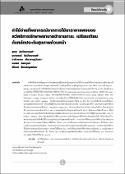บทคัดย่อ
ยาซึ่งเป็นส่วนสำคัญของการรักษาพยาบาลผู้ป่วยนอกมีแบบแผนการใช้ในระบบสวัสดิการรักษาพยาบาลข้าราชการที่แตกต่างจากระบบหลักประกันสุขภาพถ้วนหน้า การศึกษานี้วิเคราะห์ข้อมูลอนุกรมเวลา 57 เดือน ระหว่างปี 2546 – 2550 และพยากรณ์การสั่งใช้ยาในระดับรายใบสั่งของโรงพยาบาลศูนย์และโรงพยาบาลทั่วไปรวม 6 แห่ง โดยเลือกจาก 4 กลุ่มข้อบ่งใช้ที่มีค่าใช้จ่ายสูงหรือมีการใช้บ่อย ได้แก่ ยา angiotensin-converting enzyme inhibitor (ACEI) และ angiotensin-2 receptor blocker (ARB); ยาควบคุมไขมันในเลือด; ยาลดการหลั่งกรด proton pump inhibitor (PPI) และ histamine-2 receptor antagonist (H2RA) และยาต้านอักเสบที่ไม่ใช่สเตียรอยด์ (non-steroidal anti-inflammatory drug, NSAID) และ COX-2 inhibitor โดยพิจารณาองค์ประกอบของค่าใช้จ่าย 2 ด้าน คือ โอกาสใช้ยาเป้าหมายซึ่งเป็นยานอกบัญชียาหลักแห่งชาติ หรือยาที่มีผู้จำหน่ายรายเดียวซึ่งมักมีราคาแพง และปริมาณยาที่ใช้ ผลการพยากรณ์ค่าใช้จ่ายด้วยสมการถดถอยแบบเป็นช่วง (segmented regression) ก่อนและหลังนโยบายจ่ายตรงของสวัสดิการรักษาพยาบาลข้าราชการและการยกเลิกค่าบริการ 30 บาทของหลักประกันสุขภาพถ้วนหน้า พบว่า สัดส่วนการใช้ยาเป้าหมาย ได้แก่ ยา ARB ยาควบคุมไขมันในเลือดที่อยู่นอกบัญชียาหลักแห่งชาติ ยาลดการหลั่งกรด PPI ที่มีผู้จำหน่ายรายเดียว และ ยา COX-2 inhibitor มีความสัมพันธ์กับค่าใช้จ่ายรวมและการเติบโตของค่าใช้จ่ายสำหรับกลุ่มยาทั้งสี่ วิธีจ่ายเงินแก่โรงพยาบาลแบบปลายปิดซึ่งใช้ในระบบหลักประกันสุขภาพถ้วนหน้า หากนำมาใช้กับระบบสวัสดิการรักษาพยาบาลข้าราชการสามารถลดค่าใช้จ่ายลงได้ตั้งแต่ ร้อยละ 40 (กรณียาลดการหลั่งกรดและยาต้านอักเสบ) ถึงร้อยละ 100 (กรณียาควบคุมไขมันในเลือด) สำหรับมาตรการแทนยาเป้าหมายด้วยยาทางเลือกที่มีราคาถูกกว่า การประหยัดค่าใช้จ่ายขึ้นกับความสามารถในการแทนยา หากทำได้ร้อยละ 20 จะทำให้ประหยัดค่าใช้จ่ายประมาณร้อยละ 8 (กรณียาลดการหลั่งกรดและยาต้านอักเสบ) ถึง ร้อยละ 20 (กรณียาควบคุมไขมันในเลือด) และหากทำได้ร้อยละ 80 จะสามารถประหยัดค่าใช้จ่ายได้ร้อยละ 30-80
บทคัดย่อ
Therapeutic drugs, a major component of outpatient care have made the utilization pattern in the
Civil Servant Medical Benefit Scheme (CSMBS) different from the Universal Health Coverage Scheme
(UCS). This study analyzed a time-series of 57 months during 2003-2007 for drug prescriptions in 6 Regional
Hospitals and General Hospitals and forecast the overall expenditure. Four therapeutic classes
with high expenditure or frequent use, including angiotensin-converting enzyme inhibitors (ACEI) and
angiotensin-2 receptor blockers (ARB); antilipids; proton pump inhibitors (PPI) and histamine-2 receptor
antagonists (H2RA); and non-steroidal anti-inflammatory drugs (NSAID) plus COX-2 inhibitor were analyzed
with respect to two expenditure components; (1) propensity to use the target drugs, which are not
covered by the National Lists of Essential Medicines or are the single-source products, and (2) the utilization
quantity. Results from the expenditure forecast before and after the CSMBS’ direct billing policy and
the UCS’ 30-Baht copay abolition policy using a segmented regression analysis revealed that the use of the
following target drugs, including ARB, non-essential antilipids, single-source PPI and COX-2 inhibitor
was associated with the total and expenditures growth of the four classes. The close-end method of provider
payment currently employed by the UCS, if applied to the CSMBS would be able to reduce 40
percent of the expenditures for PPI-H2RA and NSAID-COX-2 inhibitor to 100 percent of the expenditure
for antilipids. For the substitution measure, the degree of cost-saving would depend largely on the policy
compliance levels. With the 20 percent compliance, 8 percent of the expenditures for PPI-H2RA and NSAIDCOX-
2 inhibitor and 20 percent for antilipids could be saved. With the 80 percent compliance, the costsaving
would range from 30 percent to 80 percent.


